“The Music of the Irish” has been hosted by Fordham students on WFUV (90.7 FM), the University’s public media station, since the mid-1970s. And next year, the show’s community of listeners and hosts will celebrate its 50th anniversary with a series of events, including a concert at Symphony Space in Manhattan on January 20. Cillian Vallely and Kevin Crawford of the band Lúnasa, Patrick Mangan and Alan Murray, Séamus Egan of Solas, and Celtic Cross are among the artists expected to perform.
The Voice of Irish New York
Ceol na nGael’s origin story is renowned at WFUV, where the show airs live every Sunday from noon to 4 p.m. In January 1974, Fordham students Gerry Murphy, FCRH ’76, and Mary Maguire, FCRH ’77, proposed a traditional Irish music segment during one of WFUV’s fundraisers. They knew the music would be popular among New York’s Irish expat community, but the result astonished them.
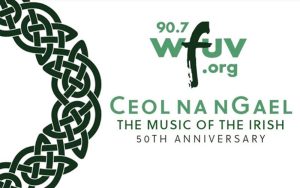 “We were totally unprepared for how the phones exploded during the first program,” Maguire recalled. “The pledges—and the checks—poured in.”
“We were totally unprepared for how the phones exploded during the first program,” Maguire recalled. “The pledges—and the checks—poured in.”
One scheduled hour of Irish tunes quickly grew into four. When Maguire had to leave the studio to go to her waitressing job, listeners called the restaurant to complain. Such was Ceol na nGael’s impact from the very start.
Over the past 50 years, the show has grown to be so much bigger than a short fundraising segment, even bigger than Fordham itself. It has become, quite literally, the community voice of Irish New York. Tuning in to Ceol na nGael on Sundays is what many hosts and listeners describe as a ritual. Frank McCaughey, FCRH ’02, GSE ’08, who hosted the show from 1999 to 2002, called it a “permanent fixture in our lives.” And former host Marie Hickey-Brennan, FCRH ’83, lovingly recalled how her grandmother, born in County Monaghan, Ireland, forbid anyone in the house from speaking during each broadcast so she could hear every note, every word.
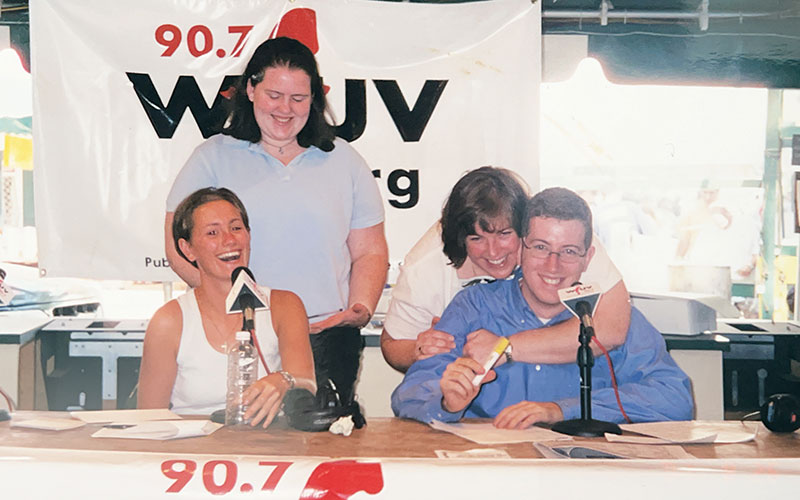
A Loyal Fanbase
Today, Ceol na nGael represents the Irish parish writ large across New York City and the tristate area, providing the intimate familiarity of parochial Ireland to more than 30,000 listeners each week. The broadcasts also reach fans across the Atlantic who tune in to the livestream to connect with the Irish community in New York. One of the show’s distinguishing characteristics is its interaction with listeners. Many of the songs played on air are requested by people who call in, and who get to know the hosts personally.
When asked about their favorite memories of the show’s first five decades, former hosts praised Ceol na nGael’s loyal fanbase. Kevin Quinn, FCRH ’09, marveled at the show’s non-Irish listeners: “It’s just a testament to the program and, of course, the appeal of the ceol.” Kerri Inman (née Gallagher), FCRH ’11, laughed about an interaction with an Irish fan who told her she pronounced her own surname incorrectly. Patrick Breen, FCRH ’22, had arguably the most challenging hosting career, recording the show at home at the start of the COVID-19 pandemic. But the listeners “never failed to provide us with the support and love we needed,” he said.
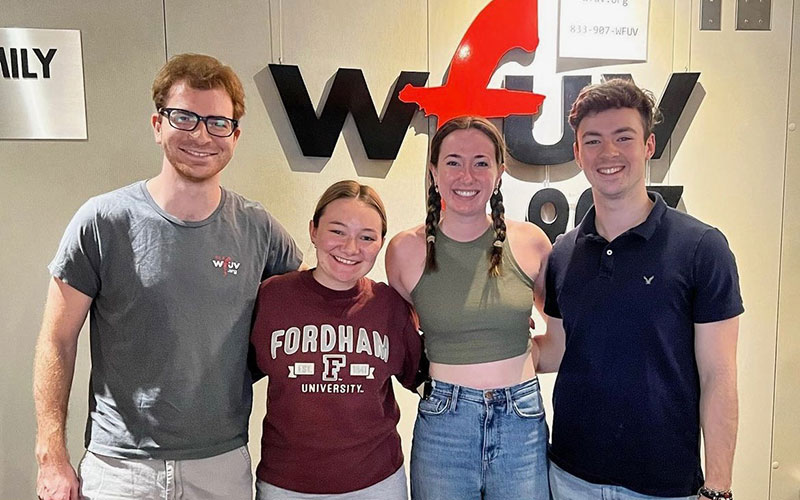
Cultural Ambassadors and Media Professionals
From the beginning, Ceol na nGael has been a notably transformative experience for its student hosts, molding them into young media professionals and ambassadors for Irish culture. I can speak to this from personal experience. Hosting the show from 2009 to 2012 defined my education at Fordham, sending me to Trinity College Dublin for a graduate degree and to my current career as a professor of Irish studies at Boston College. What I do in the classroom and in my scholarship is an extension of what I did in the studio every Sunday: reclaiming Irish creativity and history.
Many other hosts went on to build careers shaped by their time at WFUV, including broadcast journalist Patti Ann Browne, FCRH ’87, who was an anchor at MSNBC and Fox News; Mary Snow, FCRH ’85, who worked at CNN; Deirdre McGuinness, FCRH ’04, who went into professional fundraising; and Kathleen Biggins, FCRH ’87, GSE ’91, who hosts WFUV’s traditional Celtic music show, A Thousand Welcomes, from 8 to 11 on Sunday mornings.
‘Something So Much Bigger Than Myself’
Ceol na nGael has also been part of historically significant moments for the Irish diaspora. Deirdre McGuinness recalled broadcasting the show mere days after 9/11, for example, using Irish ballads to bring the community together through “hope and healing,” she said. And in the early ’90s, Eileen Byrne Richards, FCRH ’93, interviewed young people from Northern Ireland who participated in Project Children‘s summer program, spending time in the U.S. as a reprieve from the Troubles, the violent sectarian conflict between unionists and nationalists. The experience left an indelible impression: “I felt like I was part of something so much bigger than myself, and that still has an impact on me,” she said, expressing a sentiment echoed by all Ceol na nGael hosts, no matter when they stepped to the mic.
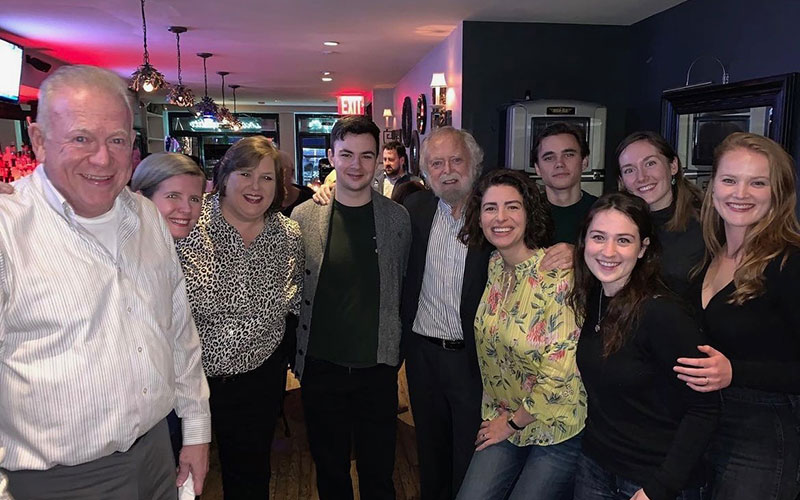
For centuries, folk music has been colonial Ireland’s language of endurance, ever present historical artifact, and compass back home. No one knows this better than Ceol na nGael‘s 40-plus hosts, including current Fordham students Allie Small and Matt Cuzzi. The show regularly airs ballads like “The Fields of Athenry” and “The Town I Loved So Well,” earmarking the history of colonial struggle from which so many Americans are descended. And it has always found the balance in Irish music’s paradoxical duality, between its lament of injustice and its jubilant expression.
As the upcoming 50-year celebration brings to the fore, Ceol na nGael isn’t just entertainment, it is a living, continuously up-to-date archive of Irish cultural resilience. You can join the celebration at the 50th anniversary concert on January 20, 2024, at Symphony Space in Manhattan. Learn more and purchase your tickets at the Symphony Space website.
—Colleen Taylor, Ph.D., FCRH ’12, a professor of Irish studies at Boston College, hosted Ceol na nGael from 2009 to 2012. She is the author of the book Irish Materialisms: The Nonhuman and the Making of Colonial Ireland, 1690-1830, which is scheduled for publication by Oxford University Press in March 2024.
Related stories
Finding Ireland Outside of Its Myths: Personal Notes on the New York-Irish Connection
]]>President Michael D. Higgins will speak as part of Fordham’s Humanitarian Lecture Series
New York, New York, Sept. 17—Fordham University will host Michael D. Higgins, president of Ireland, on Monday, Sept. 30. He will speak at the Lincoln Center campus at 11 a.m.
President Higgins, who has campaigned for human rights, peace, democracy, equality, and justice throughout his years as a political leader, will deliver a talk on “Humanitarianism and the Public Intellectual in Times of Crisis” as part of the Ireland at Fordham Humanitarian Lecture Series, a partnership between the Permanent Mission of Ireland to the United Nations and Fordham’s Institute of International Humanitarian Affairs.
In his address, President Higgins is expected to focus on the impact of migration on Ireland and the United States, and the importance of adequate support in present circumstances for people forced to flee their homes as a result of poverty, conflict, or climate change.
“Fordham is honored to host President Higgins, and to have him speak to the University community,” said Joseph M. McShane, S.J., president of Fordham. “He is an eloquent, compassionate, and thoughtful leader, and his commitment to serve the most vulnerable among us makes him an especially fitting choice to deliver this humanitarian lecture.”
Brendan Cahill, executive director of the Institute of International Humanitarian Affairs, added, “At a time when world politics has become defined by how nations undermine international agreements, it is a great honor to welcome a leader who celebrates multilateralism, who speaks clearly about not only the Irish history of hunger, migration, and violence but its contribution to peace, to education, to an ethical and humanitarian approach to world issues.”
Michael D. Higgins has served as the president of Ireland since November 2011. A passionate political voice, poet and writer, academic and statesman, human rights advocate, promoter of inclusive citizenship, and champion of creativity within Irish society, President Higgins has previously served at almost every level of public life in Ireland, including as Ireland’s first minister for arts, culture and the Gaeltacht.
Born in Limerick City and raised in County Clare, he was a factory worker and a clerk before becoming the first in his family to access higher education. He studied at University College Galway, the University of Manchester, and Indiana University. As a writer and poet, he has contributed to many books covering diverse aspects of Irish politics, sociology, history, and culture.
President Higgins was the president of the Labour Party from 2003 until 2011, when he resigned following his election as president of Ireland.
The Ireland at Fordham Humanitarian Lecture Series, a multiyear partnership between the Permanent Mission of Ireland to the United Nations and Fordham’s Institute of International Humanitarian Affairs (IIHA), explores the challenges facing policymakers and humanitarians as they seek to ensure aid reaches those in need, that humanitarian principles are upheld, and that civilians are protected. Specific topics of discussion include humanitarian protection through international humanitarian law, humanitarian financing, climate and security. The inaugural lecture at the United Nations Headquarters in New York on April 29th by former President, H.E. Mary Robinson, Chair of the Elders. The series will run until June 2020 with events in New York, Dublin, and Geneva.
About Fordham University
Founded in 1841, Fordham is the Jesuit University of New York, offering exceptional education distinguished by the Jesuit tradition across nine schools. Fordham awards baccalaureate, graduate, and professional degrees to approximately 15,000 students from Fordham College at Rose Hill, Fordham College at Lincoln Center, the Gabelli School of Business (undergraduate and graduate), the School of Professional and Continuing Studies, the Graduate Schools of Arts and Sciences, Education, Religion and Religious Education, and Social Service, and the School of Law. The University has residential campuses in the Bronx and Manhattan, a campus in West Harrison, N.Y., the Louis Calder Center Biological Field Station in Armonk, N.Y., and the London Centre in the United Kingdom.
Contact:
Gina Vergel
[email protected]
(646) 579-9957
“The Dead,” the concluding story in James Joyce’s 1914 collection Dubliners, is one of the most beloved and resonant works in Irish literature. It is set in turn-of-the-20th-century Dublin, on a snowy evening at the end of the Christmas season. A married couple, Gabriel and Gretta Conroy, arrive at the home of Kate and Julia Morkan for the sisters’ annual Feast of the Epiphany celebration.
It’s an evening of merriment and melancholy. They dine, dance, hear music, and give toasts. All of those assembled—with the exception of one intoxicated guest and one full of political passion—try their best to suppress their differences in the name of harmony and “Irish hospitality.”
Dublin by Way of the Upper East Side
The dramatization of Joyce’s story, which opened on November 18, takes place at the American Irish Historical Society on Manhattan’s Upper East Side. The society’s stately stone-and-brick Fifth Avenue town house, across the street from the Metropolitan Museum of Art, beautifully evokes the period in which the story is set.
For the dress rehearsal, I joined three of my students: computer science majors Zainab Shaikh and Chenelle Simpson, and environmental science major Lauren Beglin. Seated at the head table alongside the actors, we were served a holiday feast inspired by the one in the story and drawn into the events detailed by Joyce.
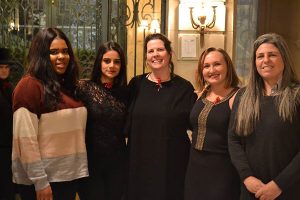
Seeing Joyce’s Protagonist in a New Light
As the evening neared its end, we and several dozen other guests were invited up one flight of stairs to witness the climax of the story: Gabriel and Gretta’s post-party confrontation in a room at the Gresham Hotel. In this scene, staged in a darkened room with only a bed in it, Gretta recalls a lost love of her youth.
Lauren Beglin said the dramatization led her to reconsider the opinion she had formed of the story’s protagonist.
“In my initial reading of ‘The Dead,’ I did not have a very high opinion of Gabriel, especially in his treatment of Gretta in the final scene of the story. Seeing this scene brought to life, however, completely changed my view of him,” she said.
“Instead of a whiny man who could not bear the idea of his wife having a life before him, the actor’s performance recast him as a heartbroken man who loved his wife with all his heart and soul, but would never be able to truly express that to her because of her past, and would never be able to live up to her idea of love. It was a scene that humanized a character I formerly hated and completely changed my experience of ‘The Dead.'”
Chenelle Simpson said the production helped her realize that the characters of Gabriel and Gretta might be based not only on Joyce’s own life but also on the experiences of one of his important literary precursors, William Butler Yeats.
“The story reminded me of [Yeats’ muse] Maude Gonne, who also suffered a loss [that of her child], and how Yeats, like Gabriel, was unable to receive her ideal affection,” Simpson said. “Yeats, being such an inspiration at this time and being only 17 years older than Joyce, could possibly have influenced the characterization of Gabriel.”
An Intimate, Immersive Experience
Zainab Shaikh found herself impressed by the feats of acting required in immersive theater.
“One of the major lessons I learned was about the art of being in character but also connecting with your audience,” she said. “How can they keep us feeling comfortable? Do we communicate on the basis that it’s 1904 or 2017?
“They gracefully responded to all of our interactions and wove them into a great production. Their hospitality truly immersed me into Joyce’s world, their humor allowed me to loosen up, and the intimacy of the vast set, as paradoxical as that sounds, allowed for one-on-one interactions that seem to be missing from many theatrical shows.”
This year marks the second holiday season in which Dot Dot Productions, in collaboration with the Irish Repertory Theatre and the American Irish Historical Society, is staging Joyce’s story. The Dead, 1904 was adapted by Paul Muldoon and Jean Hanff Korelitz, and it is directed by Ciarán O’Reilly. The production is scheduled to run through January 7.
—Keri Walsh, Ph.D., is an associate professor of English at Fordham and the director of the University’s Institute of Irish Studies. She’s also the editor of Broadview Press’ 2016 edition of Dubliners. In a brief essay posted on the Broadview website, she describes the experience of editing and annotating “Joyce’s first masterpiece,” referring to “The Dead” as her “favorite story to edit, just as it is my favorite to read.”
This story was first published in English Connect, the Fordham English department’s blog.
“Waking The Feminists,” which was held at the Lincoln Center campus on Feb. 28, followed similar events in Ireland protesting the decision of the Abbey Theatre—the country’s national theater company—to mark the centenary of Ireland’s independence with a program that included just one play written by a woman, and just three directed by a woman.
Keri Walsh, PhD, assistant professor of English, said the gathering was about signaling to Irish women in the arts that their voices are being heard in New York, and that their campaign is sending a galvanizing message to theatre makers here. The day’s events consisted of scholar’s panel and a practitioners’ panel and were well timed, falling on the same night as the Oscars, she said.
“The problem is not just an Irish problem, but also an American one; not just a problem in theater, but also in film and television, and not just a problem for women, but also for people of color, working class people, and anyone who hasn’t been traditionally included in storytelling on all of our various kinds of stages,” she said.
The eight member practitioners’ panel included a paper by Lucy McDiarmid discussing the subtle ways that Lady Gregory, who co-founded the Abbey with William Butler Yeats, was and was not a feminist. It also included remarks by Elizabeth Brewer Redwine about the life and work of Sara Allgood, an actor whose success took her all the way to Hollywood in the 1930s.
Clair Wills, PhD, the Leonard L. Milberg Professor of Irish Letters at Princeton University, said that protests against the exclusion of women from Irish theater are depressingly familiar. Similar protests erupted as recently as the early 1990s, when the first three volumes of the Field Day Anthology of Irish Writing (W. W. Norton & Company, 1991) were released with little female representation.
“We need to reflect on the fact that this kind of feminist protest appears to have so little purchase that there is little memory of previous iterations. [That] is partly what allows the persistent ignorance of women’s work and women’s representations to continue,” she said. Wills said that when she helped edit follow-up volumes, she and her co-editors took on the task of rectifying the glaring errors.
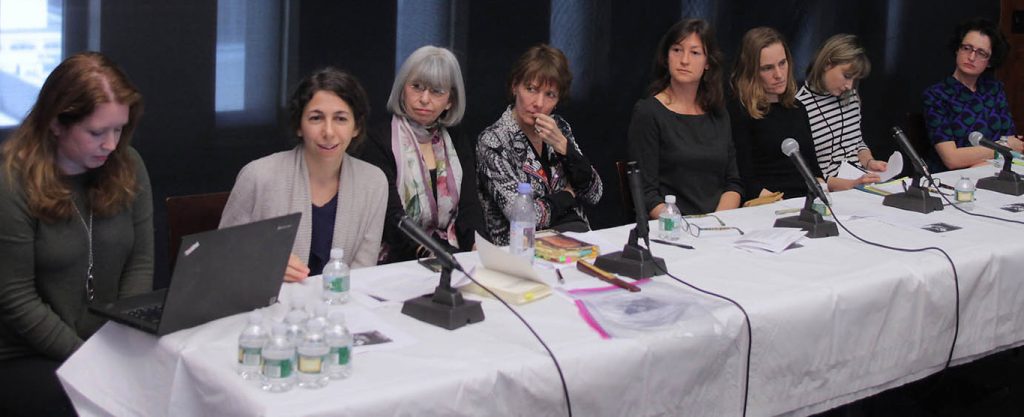
The Feb. 28 event was sponsored by Fordham’s Institute of Irish Studies and supported by Mary Brautigam, TMC ‘74, and Richard Brautigam, FCRH ’73.
Richard Brautigam said the couple, both of whom are Irish citizens, hopes to bring to Fordham the sort of scholarship and open inquiry that can be found at NYU’s Irish House, where they are members. Brautigam noted that Fordham’s history is steeped in Irish history as its founder, Archbishop John Hughes, hailed from the Emerald Isle.
“He was the greatest defender if the Irish in New York, and it’s because of him that we’ve been able for the last 150 years to proudly raise our heads above the parapet,” he said.
Mary Brautigam likewise credited Fordham with helping her build a future in the United States. She was the first of her family to be born here, and the first to graduate from college, thanks to generous financial aid she received.
“Fordham is hugely important to a great number of Irish Americans in giving them a chance for an education,” she said.
“We thought Fordham, with its legacy, would be a great place to expand the offerings in New York City of Irish culture.”
John P. Harrington, PhD, director of the institute and Dean of Arts and Sciences Faculty, said that thanks in part to the Brautigam’s generosity, Irish studies is enjoying a resurgence of interest at Fordham, as the country’s history is intertwined with not only the history of the University, but also the Catholic Church and New York City.
In addition to Waking the Feminists, the Institute will be hosting three more events this year, including a night of music and dance with the band the Narrowbacks on March 10, a presentation by Man Booker Prize-winner Anne Enright on Sunday, April 17, and an event featuring Peter Quinn and Terry Golway on Friday, May 6.
“There is a real interest in Ireland and contemporary events, because its about how small countries function in the European union, its about asylum issues; it’s a great introduction to global conflicts and issues,” he said. “It’s not just of interest to people of Irish heritage.”
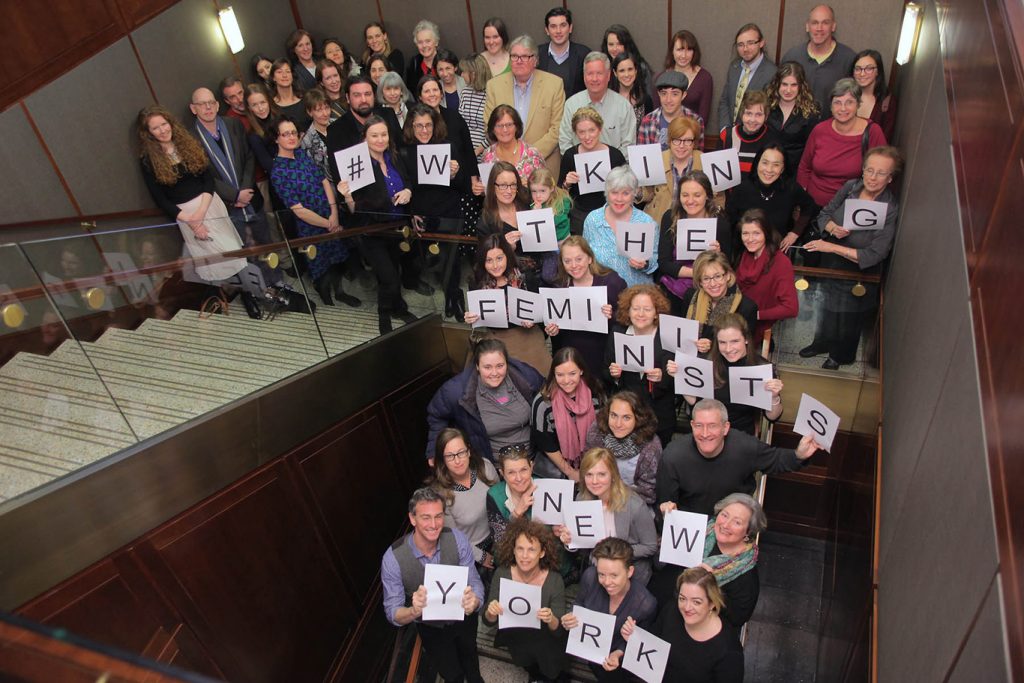
“Everything in Ireland has changed dramatically over the last few years,” he said. “For many researchers it’s all about getting away from the Irish American myth: that whole male-focused, men-drinking stereotype.”
Under Harrington’s direction, the Institute of Irish Studies has scheduled a number of events this spring that continue to embrace tradition while busting convention.

“Many contemporary immigrant cultures address the same issues as the Irish did, and still do: Being in America, not being fully admitted, and dealing with stereotypes.”
On March 11, the institute sponsored a symposium on Irish women writers, organized by Keri Walsh, PhD, assistant professor of English.
“One of the issues of investigating a country that is heavily mythologized is not to perpetuate a cliché,” said Walsh. “So the work of women writers is great way to unpack some of these myths.”
Walsh said that even W.B. Yeats and the Lady Augusta Gregory were accused of co-opting and misrepresenting authentic Irish culture when they started the world-renowned Abbey Theater. She said later, women writers, like poet Eavan Boland and novelist Edna O’Brien, spent their careers seeking a more nuanced approach to portraying the Irish as well, by showing the ways in which certain key myths, such as that of Cathleen ni Houlihan, depended on women as a symbols, even while women were not fully included in the political life of the nation.
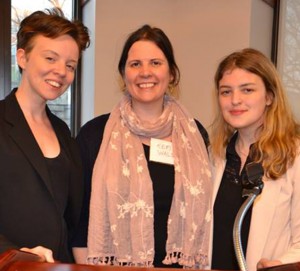
At the symposium, playwright Geraldine Hughes discussed her support for integrated education for Catholic and Protestant children in Northern Ireland. Author Belinda McKeon talked about the continuing challenge of writing from the viewpoint of a female protagonist in a literary tradition that has long been defined from a male point of view (her forthcoming novel, Tender, is told from the point of view of a semi-autobiographical heroine). Ora Tinsley, who has cystic fibrosis and is the author of Salty Baby, talked about her experiences growing up in the Irish healthcare system and her advocacy for people with cystic fibrosis in Ireland and beyond.
The institute will continue to shake up expectations with the Gaelic Society on March 27 at 6 p.m. when the band Celtic Cross comes to the Rose Hill campus.
Other outings and events include an April 20 production of an Eamon Grennan play based on the women in W.B. Yeats’s life and works, titled The Muse and Mr. Yeats. And on July 9 a full day symposium at the Pope Auditorium will coincide with the Druid Theatre’s Shakespeare at the Lincoln Center Summer Festival.
Happy St. Patrick’s Day!
]]>
You can catch her work on The McGowan Trilogy through Oct. 5. Fordham students and staff get a ticket discount online using the code FORDHAM. (Photos by Sulei Ly)


Novelist Peter Quinn, GSAS ’75, headed up an all-star program at the Museum of the City of New York on March 13. Readings and a discussion centered on Fordham founder Archbishop John Hughes, with Quinn being joined by historian Terry Golway, columnist Dan Barry, poet Honor Molloy, and museum trustee Jim Quinn moderating.
The evening, titled, “Immigrant, Archbishop, and Politician: John Hughes and the Rise of Irish New York,” provided riveting accounts of Hughes’ tenure as the champion of the Irish at a time when million’s of the isle’s starving arrived in New York.
Quinn called it “the perfect marriage of the man and the moment,” creating in Hughes the “prototypical in-your-face New Yorker, [like]Al Sharpton with a brogue.”
He noted that the ever-persuasive Hughes induced the Jesuits to move from Kentucky to Fordham with none-to-subtle advice that the best thing for them to do “was to get the hell out of town” and move to the Bronx.
Later, during the discussion with Goloway, Peter Quinn noted that any analysis of the Tammany Hall era of New York without a focus on the Irish famine is an incomplete history.
“Some call that revisionism,” he said. “I call it history.”
]]>McCarthy was the founder and first director of Fordham’s Institute for Irish Studies, has written extensively on Irish, Northern Irish and Irish American subjects, and has made numerous media appearances commenting on the state of Ireland and the Irish Diaspora.

The award ceremony comes less than a week after Comptroller William C. Thompson Jr. announced a deal to invest $150 million in city pension funds in Northern Ireland. The investment, made to the Emerald Infrastructure Development Fund, will target projects in waste management, health care, and alternative and conventional energy.
At the celebration, Thompson credited McCarthy with strengthening ties between Ireland and New York City. “He has achieved notoriety as a prolific author of books, numerous articles and reviews across a broad array of journals and papers dedicated to Irish history and culture,” Thompson said.
The other honorees were: choreographer Darrah Carr, model and actress Karen Duffy, Mutual of America executive William J. Flynn, labor priest Brian Jordan, OFM, and Irish Echo publisher Máirtain Ó Muilleoir.
The event was co-sponsored by the Brehon Law Society and the Emerald Isle Immigration Center.
]]>Duns made the most of modern technology, posting lessons and information on www.whistlethis.com and his own blogspot, “A Jesuit’s Journey.” A YouTube broadcast of Duns playing the classic “Star of the County Down” and other lessons are currently available online.

The Institute of Irish Studies will offer a one-credit course in Irish dance in fall 2007, and hopes to host more cultural classes and events, as a way to tap into Irish-American students’ interest in their roots, said Eoin O’Connell, the program’s administrative director.
The Institute and the New York Eighteenth Century Seminar will co-sponsor a March 1 lecture on Jonathan Swift at Fordham’s Lincoln Center campus by Ian Campbell Ross of Trinity College, Dublin. Irish studies is currently offered as a minor to Fordham undergraduates, who must take one literature, one history and four other courses to fulfill the requirement.
]]>DATE: WEDNESDAY, NOV. 2
TIME: 6:30 P.M.
PLACE: PLAZA ATRIUM
LOWENSTEIN CENTER, LINCOLN CENTER CAMPUS
113 WEST 60TH STREET, NEW YORK, NY
O’Toole, a journalist for the Irish Times and a former drama critic for the New York Daily News, will discuss how Ireland’s burgeoning economy has influenced culture and the arts in Ireland. He is the author of The Ex-Isle of Erin: Images of a Global Ireland (New Island Books, 1997) and several other books about Ireland.
Established in 1998, Fordham University’s Institute of Irish Studies has emerged as one of the premier centers of Irish cultural scholarship and research in New York City. It promotes scholarly interest in Irish history, society and culture, and serves as a springboard for undergraduate programs in Irish studies.
]]>DATE: TUESDAY, SEPT. 27
TIME: 6:30 P.M. to 8:30 P.M.
PLACE: WILLIAM D. WALSH FAMILY LIBRARY
FORDHAM UNIVERSITY, ROSE HILL CAMPUS
441 EAST FORDHAM ROAD, BRONX, NY
Tim O’Connor, consul general of Ireland in New York, will speak at the opening of the exhibit, which will be on display throughout the fall semester.
Established in 1998, Fordham University’s Institute of Irish Studies has emerged as one of the premier centers of Irish cultural scholarship and research in New York City. It promotes scholarly interest in Irish history, society and culture, and serves as a springboard for undergraduate programs in Irish studies.
]]>